
Autism and obsessive-compulsive disorder, affecting millions worldwide, can often be seen overlapping. Autism spectrum disorder is a neurodevelopmental disorder in which the person tends to indulge in repetitive or restrictive behaviors. OCD, known for repetitive traits, can be either misdiagnosed or a missed diagnosis in people with autism. Even after being diagnosed with autism, it becomes highly important for a physician to look into the nuances of identifying OCD.
Autism and OCD
Before unraveling the knots between autism and OCD, we must understand what these conditions are and how they are presented.
Autism Spectrum Disorder (ASD) is a neurodevelopmental disorder in which symptoms like repetitive behavior, interests, or activities and problems in social interactions are noted.
On the other hand, obsessive-compulsive disorder (OCD) is a mental health disorder. Obsessions are viewed as recurring, unwelcome thoughts or images that are experienced as disruptive and distressing. Compulsions are repetitive actions or thoughts that are done to lessen anxiety.
Occurrence of OCD in Autism
For children with autism, the presence of OCD can be easily missed due to their intersecting symptoms. Understanding this overlap and providing the right treatment can provide a little relief. Numerous studies have revealed that anxiety disorders like OCD are relatively common in ASD. What you should be aware of is that these symptoms are highly varied; while one may experience unusual phobias, another may develop a specialized interest.
According to studies, up to 84 percent of autistic individuals experience anxiety in some way; up to 17 percent may have OCD specifically.
Ultimately, what causes autism can also cause anxiety, but their exact pathophysiology is quite unclear. On a day-to-day basis, any social or environmental-based discomforts for people with autism can fuel anxiety, which is an important component of OCD. For example, jarring noise or even advertisement jingles may cause a sensory disturbance in autistic people, which could contribute to anxiety.
Missing Diagnosis and Challenges
OCD can be challenging to distinguish from autism as the compulsions can resemble repetitive behaviors, which are also commonly seen in autistic people. However, several studies have suggested a thin line of differences that are important to note and can be helpful in the diagnosis.
In OCD, individuals experience intrusive thoughts because of which they want to do a certain action even though they are not willing to do it. By compulsively doing this, it can help in lessening their anxiety buildup. But in autism, they have the choice to choose the activity, and they do that repetitively because it soothes or comforts them.
Thus, communication of this motive becomes vital. However, the real problem is that autistic individuals may not be able to articulate why they are doing certain things. This could possibly lead to a misdiagnosis.
Many other factors can hinder diagnosing OCD in autism, which include:
- insight
- ability to recognize emotions
- co-occurring intellectual disability
- communication
- language impairments
- minimally verbal children may be overestimated or underestimated by parents for anxiety disorders.
- lack of emotional insight even in verbally well-versed children.
Best Treatment Approaches
When it comes to any spectrum of disorders, utilizing effective treatment approaches can help lessen the burden. Youth with anxiety, ASD, and other mental health conditions respond well to cognitive-behavioral therapy (CBT), a clinically proven therapy for anxiety.
By using visual, interactive, and heightened parental involvement, the following can be achieved by CBT:
- child engagement
- comprehension
- retention
- generalization
Talking about medicines, several pharmacological remedies are also under research for treating OCD in children with autism. However, these medicines must be taken cautiously with proper care and supervision.
Conclusion
In conclusion, understanding the overlap between autism and OCD is crucial for accurate diagnosis and effective treatment. With proper intervention, including cognitive-behavioral therapy and cautious medication use, individuals can find relief from symptoms and improve their quality of life. Healthcare providers and families need to work together to address the unique needs of individuals with these co-occurring conditions.
Frequently Asked Questions (FAQs)
1. Do all people with autism have OCD?
Not really, autism spectrum disorders can be presented with a variety of symptoms. Among them, anxiety disorders can be manifested in different ways and one such component is OCD.
2. What are the common symptoms of OCD and autism?
One main thing is the behavior of repetition. While in OCD the person does that compulsively with built-up anxiety, in autism repetitive acts are done for soothing or comfort.
3. Are there any standard assessment tools for properly diagnosing OCD under autism?
Yes, Brief, informant report measures include the Child and Adolescent Symptom Inventory (CASI), which is a tool that can help in identifying the overlapping symptoms of OCD and autism.; the autism Spectrum disorders-Comorbidity for Adults Scale (ASD-CA); and the Anxiety Scale for Children with Autism Spectrum Disorder (ASC-ASD).
4. How can the right diagnosis aid in the treatment?
For the best possible treatment for ASD, it is important to consider the co-occurring conditions such as anxiety and OCD. To improve the child and family's overall quality of life, it will be crucial to develop interventions that concentrate on the child's critical behavioral and emotional functioning. These strategies may have a cascading effect on several other domains.


.png)


